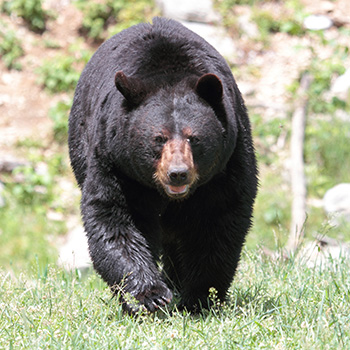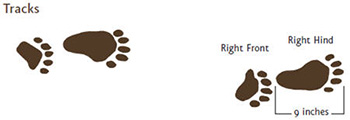Bears in North Carolina

Photo courtesy of Cephas
By the Site Ecology Team (SET), Wildlife and Industry Together (WAIT) Bill Willis, Bill Steinmetz, John McLamb
December 11, 2014
It’s not recommended that you do that or even offer ANY bear a lift if you see one walking along the side of the road. It would, however, be advisable to call in the sighting to local authorities to lessen the chances of a vehicle/bear accident.
You should only expect to see Black Bears, not Brown, Polar, Grizzly, or Teddy (unless lost) anywhere in the wilds of North Carolina. It may be hard to bear, but these creatures should not be fed, petted, hugged, or even approached. Most likely the bears that you’d see locally are young males just passing through to their eastern or western ranges (see map). In July 2013, a black bear visited Duke University campus, found no classes to his liking and wandered off without incident. Unfortunately, around that same time, another bear was found lifeless on a bench at NC State without student ID or books. Problems with bears and humans mainly occur when food is involved. SO, please don’t share your “pic-a-nic” basket for you’d be making a BooBoo.

Photo courtesy of North Carolina Wildlife Resource Commission
There are programs within the North Carolina Wildlife Resources Commission (NCWRC) to relocate certain wild animals (ex. turkeys and white-tailed deer) when area populations experience severe declines. Bears have not required this type of intervention. Wild black bears have moved naturally into suitable habitat areas without the need for capture and release. Even now, it would be difficult, if not impossible, to relocate a wandering bear, much less a problematic one within the State.
When the early settlers arrived, there were black bears all across North Carolina. But, as time passed, more and more bears were killed for non-food or fur purposes. The heavily wooded regions required for bear habitat were reduced for human shelter and introduction of crops and livestock. Bears were viewed as a danger to this new way of life. Another factor affecting the survival of bears was the loss of American chestnuts, a primary food source, due to the blight, that occurred in the early 1900’s and destroyed mature chestnut trees in the mountains. The most recent bear census for its occupied ranges was around 11,000 animals.

Being naturally shy and wary creatures, bears are not inclined to den near urban areas where their normal habitat has been disturbed. Occasionally a news report will air about a young bear seeking shelter under someone’s house. They will visit such locations if accustomed to, and are drawn by, the smell of human food.
While the prospect of encountering a bear on the NIEHS campus is still extremely low, there is always a possibility of seeing, or being seen by, one. The last report of a bear on campus was a foot print found and identified in 1984. Although generally considered non-aggressive toward humans, caution is always warranted. Unprovoked attacks on humans in North Carolina are extremely rare. “Usually, if a black bear attacks you, it’s an offensive attack." says Bill Stiver, a wildlife biologist at the Great Smoky Mountains National Park. In an ABC News article How to Survive a Bear Attack by Rheana Murray, Stiver makes the following observations and recommendations:
What to do if a bear approaches
If a bear approaches, make some noise. You’re trying to scare it away before it gets too close. Clap your hands, wave your arms, stand tall, yell, even throwing things is appropriate. Get a big stick, and some rocks as possible defensive weapons. Try to back away slowly to provide extra distance.
Get big and loud, but never run or climb.
If this doesn’t scare the bear away, be prepared to fight back with everything you’ve got. Punch, kick, do everything you can to get that animal off you. Stand your ground. You can’t outrun a bear.
Chances are very slim that you’ll ever have an encounter locally and have to use these tactics but knowledge is power.
Please report any bear sightings or tracks on the NIEHS campus to Security.
References can be supplied upon request.



